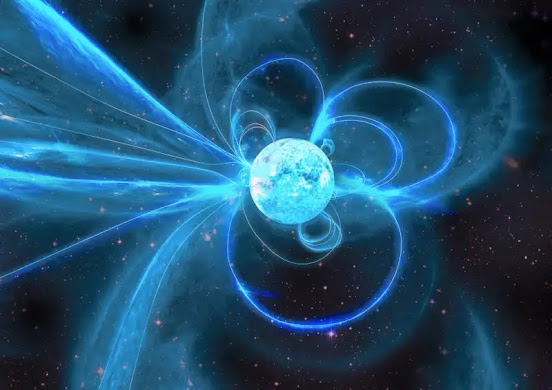Unveiling Unprecedented Activity: Observations of a Remarkable Magnetar
Astronomers detect unprecedented behavior from nearby magnetar
Artist's impression of a magnetar. Credit: Carl Knox, OzGrav/Swinburne University of Technology
Introduction:
In the vast expanse of the cosmos, celestial objects often defy our expectations, challenging existing theories and pushing the boundaries of our understanding. Recently, astronomers made a groundbreaking discovery that has captured the attention of the scientific community: unprecedented behavior observed from a magnetar in our cosmic neighborhood. This remarkable finding not only sheds new light on the enigmatic nature of magnetars but also offers valuable insights into the dynamic processes shaping our universe.
Understanding Magnetars:
To comprehend the significance of this discovery, it is essential to first grasp the fundamental characteristics of magnetars. These exotic objects belong to the family of neutron stars, remnants of massive stars that have undergone supernova explosions. What sets magnetars apart is their incredibly powerful magnetic fields, which are trillions of times stronger than those of typical neutron stars. This intense magnetism gives rise to a range of extraordinary phenomena, including sporadic bursts of X-rays and gamma-rays, making magnetars some of the most energetic objects known to science.
Key Observation:
Against this backdrop of cosmic drama, astronomers observed a magnetar known as J1818.0-1607 exhibiting a sudden and unprecedented increase in X-ray emissions. Located relatively close to Earth, this magnetar became the focal point of intense scrutiny as scientists sought to unravel the mysteries of its behavior. The surge in X-ray activity far surpassed anything previously recorded from similar objects, prompting excitement and intrigue among researchers.
Significance of the Discovery:
The discovery of such an anomalous event holds profound implications for our understanding of magnetars and the astrophysical processes at play within them. It challenges existing models and theories, forcing scientists to reconsider their assumptions about the behavior of these cosmic powerhouses. The unexpected surge in X-ray emissions suggests a dynamic and evolving environment within the magnetar magnetic field, hinting at complex and poorly understood phenomena occurring deep within its core.
Expert Insights:
Dr. Nanda Rea, a prominent astrophysicist involved in the study, offered insights into the significance of the discovery, stating, "This observation represents a new and unexpected phenomenon in the behavior of magnetars. It provides a unique opportunity to study the extreme physics at play within these enigmatic objects." Such commentary underscores the significance of the discovery and highlights the importance of continued investigation into the nature of magnetars and their cosmic significance.
Possible Explanations:
As scientists grapple with the implications of this unprecedented observation, various hypotheses have been proposed to explain the surge in X-ray emissions. One possibility is that the magnetar experienced a rare and violent event, such as a starquake—a seismic disturbance in the crust of the neutron star—or a sudden reconfiguration of its magnetic field, resulting in the release of stored energy in the form of X-rays. Alternatively, the increased activity could be indicative of ongoing processes within the magnetar interior, such as the decay of its magnetic field or the accretion of material from its surroundings.
Implications for Astrophysics:
The discovery of unprecedented activity from J1818.0-1607 opens new avenues for research in astrophysics, offering valuable insights into the fundamental processes shaping our universe. By unraveling the mysteries of magnetars and their behavior, scientists hope to gain deeper insights into the nature of matter, gravity, and the cosmos itself. Moreover, this discovery underscores the dynamic and ever-changing nature of the universe, reminding us of the limitless possibilities awaiting exploration.
Future Directions:
Looking ahead, astronomers are poised to embark on further observations of J1818.0-1607 and other magnetars, eager to monitor any additional changes in their behavior. Advanced telescopes and instruments, including the upcoming James Webb Space Telescope, promise to provide enhanced capabilities for studying these cosmic phenomena in unprecedented detail. By leveraging these cutting-edge technologies, scientists aim to unravel the mysteries of magnetars and unlock the secrets of the cosmos.
Conclusion:
In conclusion, the recent detection of unprecedented activity from a nearby magnetar represents a significant milestone in our exploration of the cosmos. This remarkable finding not only deepens our understanding of magnetars and their behavior but also underscores the dynamic and ever-changing nature of the universe. As scientists continue to unravel the mysteries of these enigmatic objects, we inch closer to unlocking the secrets of the cosmos and our place within it. The discovery of such anomalous events reminds us of the boundless wonders awaiting discovery in the vast expanse of space.
Disclaimer:
The summary provided above is a paraphrased representation of the original news article titled "Astronomers detect unprecedented behavior from nearby magnetar." The summary aims to condense the main points and key insights from the article in a simplified manner. It is important to note that while efforts have been made to accurately capture the essence of the original content, the summary may not encompass all details or nuances present in the full article. Readers are encouraged to refer to the original news article for a comprehensive understanding of the topic.




Comments
Post a Comment